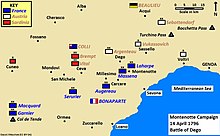| Second Battle of Dego | |||||||
|---|---|---|---|---|---|---|---|
| Part of the Italian campaigns in the War of the First Coalition | |||||||
 The second battle of Dego | |||||||
| |||||||
| Belligerents | |||||||
|
|
| ||||||
| Commanders and leaders | |||||||
| Strength | |||||||
|
14 April: 12,000 15 April: 15,000 |
14 April: 5,700 15 April: 3,500 | ||||||
| Casualties and losses | |||||||
|
14 April: 1,500 casualties 15 April: 938 casualties |
14 April: 3,000 casualties 15 April: 1,757 casualties | ||||||
  | |||||||
| Montenotte campaign | |
|---|---|
The Second Battle of Dego was fought on 14 and 15 April 1796 during the French Revolutionary Wars between French forces and Austro-Sardinian forces. The battle was fought near Dego, a hamlet in northwestern Italy, and ended in a French victory.
Background
| This section does not cite any sources. Please help improve this section by adding citations to reliable sources. Unsourced material may be challenged and removed. (September 2014) (Learn how and when to remove this message) |
After successfully defeating the Austrian right wing at the Battle of Montenotte, Napoleon Bonaparte continued with his plan to separate the Austrian army of General Johann Beaulieu from the army of the Kingdom of Piedmont-Sardinia led by General Michelangelo Colli. By taking the defences at Dego, the French would control the only road by which the two armies could link with each other. The town's defences comprised both a castle on a bluff and earthworks on rising ground, and were held by a small mixed force, consisting of units of both the Austrian and Piedmont-Sardinian armies.
Forces
Army of Italy: Napoleon Bonaparte (15,000)
- Attached to army command:
- Cavalry Division: Henri Stengel
- Corps: André Masséna
- Division: Amédée Laharpe
- Brigadiers: Jean Pijon, Jean Ménard, Jean Cervoni
- Demi-brigades: 1st Light, 14th, 21st, 69th, 70th and 99th Line
- Division: Jean Meynier
- Brigadiers: Elzéard Dommartin, Barthélemy Joubert (not present)
- Demi-brigades: 45th, 46th, 84th and 100th Line
- Division: Amédée Laharpe
Austrian Forces
- Part of Right Wing: Eugène Argenteau (5,700)
- Austrian Regiments, 1 bn each: Stain IR # 50, Pellegrini IR # 49, Schröder IR # 26, Alvinczi # 19, Terzi IR # 16, Nádasdy IR # 39, Deutschmeister IR # 4
- Austrian Regiments: Preiss IR # 24 (3 bns), Archduke Anton IR # 52 (2 bns)
- Sardinian Regiments: La Marina IR (2 bns), Montferrat IR (1 bn)
- Brigade: Josef Vukassovich (3,500)
- Regiments: Carlstadt Grenz IR (2 bns), Alvinczi IR # 19, Nádasdy IR # 39, Preiss IR # 24 (all 1 bn)
- Key
- Line = Line Infantry
- Light = Light Infantry
- IR = Infantry Regiment
- bn = infantry battalion
Battle

On 14 April, André Masséna, leading Amédée Laharpe's division and one brigade of Jean-Baptiste Meynier's division attacked the town. The French overran the defences, losing about 1,500 killed and wounded. The Austrians suffered 3,000 casualties, including a large number of prisoners. Argenteau's survivors fled northeast to the town of Acqui Terme. Bonaparte ordered Meynier to hold Dego, while he took Laharpe's division west to fight Colli's Sardinians.
However, the French troops in Dego then gave themselves over to looting, and during the night they were mostly scattered in the nearby houses. At dawn on 15 April, under cover of fog, the defences were counter-attacked by an Austrian force under Colonel Josef Vukassovich. Beaulieu planned for Vukassovich to reinforce Argenteau the day before, but his orders were poorly written and his subordinate showed up at Dego a day too late. Nevertheless, taken by surprise, the French were rapidly driven out of Dego and back to their starting point of the day before. Allegedly, the surprise attack caught Masséna in bed with a woman and he escaped in his nightshirt.
Masséna took some time to take control of the situation again. He recalled Laharpe and organised a counter-attack, which was supported by other reinforcements brought up by Bonaparte. Vukassovich's force was heavily outnumbered, and was unable to defend for long before it was driven out, leaving Dego definitively in French hands.
Results
The second day's action cost the Austrians a further 670 killed and wounded, plus 1,087 captured. The Preiss Infantry Regiment # 24 took particularly heavy losses. The French lost 621 killed and wounded, and 317 captured. The second day surprise made Bonaparte anxious that Beaulieu might intervene from the east, so the French general reorganized his forces and sent out strong patrols on 16 April. But Argenteau's mauling at Montenotte and Dego shook Beaulieu's nerve and he stayed near Acqui. Satisfied that Beaulieu was out of the picture, Bonaparte turned on Colli with his main strength on 17 April. On 21 April, The French beat Colli at the Battle of Mondovì and soon afterward the Sardinian government sued for peace.
Footnotes
- Smith, p 112. All strengths are from Smith.
- Smith, p 112. All losses are from Smith.
- Smith, p 112. Order of Battle from Smith.
- ^ Smith, p 112
- Fiebeger, p 6
- ^ Chandler, Campaigns, p 73
References
- Boycott-Brown, M. The Road to Rivoli, London, Cassell, 2001
- Chandler, David. The Campaigns of Napoleon. New York: Macmillan, 1966.
- Chandler, David Dictionary of the Napoleonic Wars. Wordsworth editions, 1999.
- Fiebeger, G. J. The Campaigns of Napoleon Bonaparte of 1796-1797. West Point, NY: US Military Academy Printing Office, 1911. Reprinted in Bonaparte in Italy Operational Studies Group wargame study folder.
- Schels, J. B. 'Die Gefechte in den Apenninen, bei Voltri, Montenotte, Millessimo, Cossaria und Dego, im April 1796.' Oesterreichische Militärische Zeitschrift, Bd. 2 (1822): 123-217
- Smith, Digby. The Napoleonic Wars Data Book. London: Greenhill, 1998. ISBN 1-85367-276-9